Since the early days of my carnivorous life, I’ve been wishing for something like mayonnaise to eat with leaner meat. Heaven forbid I should end up with leftover chicken breast, because I cooked the whole beast and the wacko lean-eaters didn’t finish it off, for example.
I tried a few times to make mayonnaise with bacon fat, but my results were inconsistent. Sometimes it broke, and even when it didn’t, it never turned out as delicious as one would think it should. Come on, it’s bacon. It ought to be divine! Yet, it remained dissatisfying. For one thing, I always found the vinegar or lemon juice to overpower the delicate taste. For another, because I hadn’t yet learned to roast bacon in the oven, the nearly inevitable bits of burn flavour from the pan were somehow always accentuated in an unpleasant way. The bottom line was nobody, not even I, wanted to eat it.
Once I discovered that I like to eat plain tallow, lard, or schmaltz on meat, or even just on a spoon, I more or less forgot about the idea, until recently, when I started wishing for it again.
The first thing you have to deal with when making carnivorous mayonnaise is the fact that animal fat is not usually pourable at room temperature. So you have to melt it first. One day, I suddenly thought about hollandaise sauce, which is basically mayonnaise but made over heat with melted butter instead of oil. The gears began turning.
In mayonnaise, it is recommended that all the ingredients are at room temperature, but in hollandaise sauce we heat the yolks about as much as possible without actually cooking them. The reason they need to be warm is that the proteins in yolks are tightly folded, and heat allows them to unfold enough to be able to surround the fat droplets and emulsify them. If they unfold too much, they start binding with each other irreversibly, and you get scrambled eggs. The reason for heating the yolks first, then, is that warmer yolks allow more emulsion, but you have to be careful.
The reason for the addition of acid took me longer to discover. There are a lot of sites claiming it’s to kill bacteria in the raw yolk. I don’t really buy that. I doubt it would be effective and anyway I’m not really concerned about it. Others mentioned that it would add surface area to increase emulsion. While that’s plausible, you could just as easily add water. I was more persuaded by people who admitted they were doing it simply for taste. That’s a fine reason, if you are into it. However, according to Jacob Burton of Stella Culinary, the real reason is that yolks normally curdle somewhere between 71-76°C, but acid raises the curdling temperature to 90°C, which gives you more of a safety net.
In my first experiments with bacon fat hollandaise, I didn’t bother with acid, and I still prefer it without. However, I did break it a few times by pouring the fat straight from the oven. Now I know better, and I’ve finally found a use for my old candy thermometer, which is one of those tools from the bad old days that I’ve kept around for no prior reason other than that I’m a recovering hoarder.
Here’s what I do to make hollandaise from animal fat, in this case using pork fat I bought from the butcher for 99¢/lb. I’ve tried butter, tallow, and blends of the three. Next time I plan to try schmaltz.
I rendered some of the fat by roasting for 20 minutes at 475°F (the pan was initially full, but it shrank).
I took off the crispy pork pieces, and left the fat to cool for a while. Then I poured the liquid gold into a small bowl easier to pour from.
I used an immersion blender to blend four yolks, with the blending cup itself immersed in a bowl of boiled water. Then once they were as thick as they were going to get, I drizzled in all the pork fat, about 6oz.
It works beautifully, and it’s easy, but best of all, I like it! (And so do my children if I happen to leave any unfinished.)
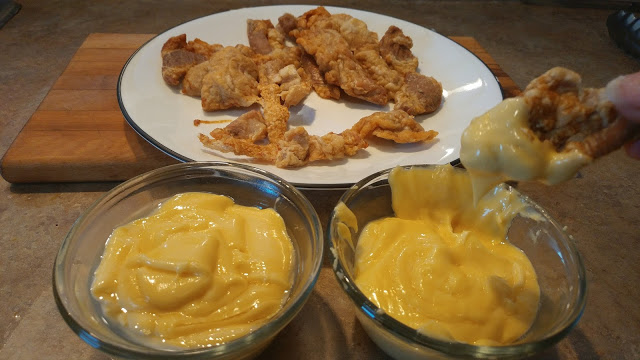
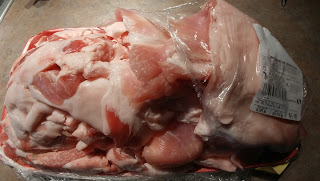
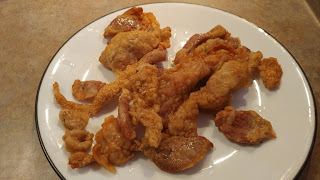
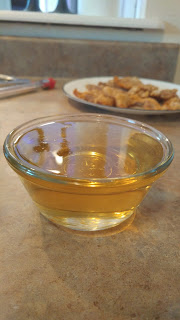
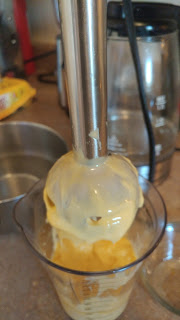
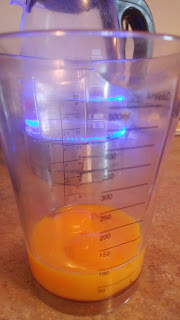
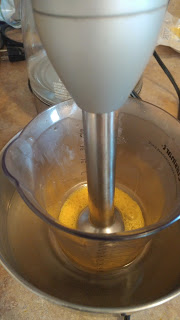
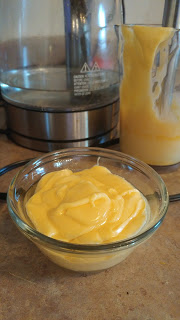
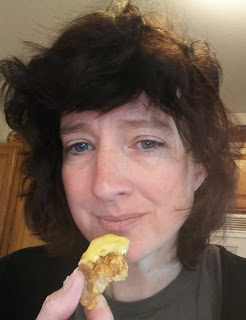
I'm definitely going to try your technique. I used an immersion blender with 1 cup of ghee (clarified butter), 3 eggs, 1 tsp lemon juice and got a great looking Mayonnaise with a consistency similar to yours but it was so sour I couldn't eat it. You have inspired me to try again without the lemon juice. I may throw in a few of my favorite spices for flavor. Thanks. Paul Mabry
Yeah, I just find it overbearing, even in small amounts.
I would add little apple vinegar if you want it sour but why? Just spices would fine.
Intriguing. If I'm too lazy to buy and render the pork fat myself, you think this might work the same with a brick of plain old lard from the supermarket?
I don't see why not, as long as it's just lard. The brick lard here is hydrogenated, which makes me a bit cautious, but you can get gourmet lard, tallow, and duck fat by the jar. You could also using bacon drippings, if you save them.
Do you have any advise on spring allergies please. .mine is really bad..thanks
So, after immersing myself in your blog, I'm ready to do this. Notice I didn't say "try." I'm ready to DO this. Today is that last day for carbs (and alcohol), and only because there's leftover Guinness Stew left over from a couple nights ago. I'll pick out the meat and maybe just a couple of the small pieces of potato. There's also one glass of wine left, so I'll have that as a "Farewell to carbs, Welcome to Eating Meat and Fat and starting to feel GOOD for a change."
I just went to the grocery store and bought all kinds of good fatty meat, like ribeyes, 80% ground beef, and pork butt. I'll throw the pork butt in the slow-cooker tomorrow morning, add salt, and maybe a bit of broth (half cup?). I'll nosh on that during the day for the rest of the week. Also bought a couple large marrow bones. I plan on roasting those and eating the marrow.
As I passed the jerky selection I decided to get a package. I knew I wanted natural, no teriyaki or other flavorings, and definitely no sugar. Know what? There wasn't ANY that didn't have sugar. I'm going to try your ribeye jerky from another post, but will need to borrow a dehydrator from someone at work first to see if I can do it and whether I like it.
Amber, you've inspired me!
Thanks! Best of luck!
Hi, Scott. That's interesting. So you had nothing like this on a "regular" ketogenic diets? I don't know what would cause that, but you might try eating leaner and see if it's an issue of too much fat. It might help with being ravenous as well.
Hi, it's Sunah. Your site doesn't recognize me.
I see your candy thermometer figures into this, and I think the boiled water the egg-blending cup is in must still be hot. I beat eggs at room temperature while a pan of bacon baked. I drizzled the hot fat in while I kept beating. Nothing happened. If I want something to happen next time, how hot should the water around the egg-blending cup and how hot should be the fat?
I'm not sad the hollandaise didn't work, because I have the pan of baked bacon now. But I do wonder if my un-transformed fatty eggs are edible, or if I should throw them away.
Thanks for all you do!
(The site gets me now)
When I put it in the fridge it thickened to the right texture. There is probably a limit to how long I should keep a raw-egg compound in the fridge, but it tastes so good I just can't get rid of it immediately.
Hi, Sunah! Thanks for trying it out. I'm not sure why it didn't take. I use boiling water to emulate a double boiler, and only yolks, and a hand blender. Did you change any of those parameters?